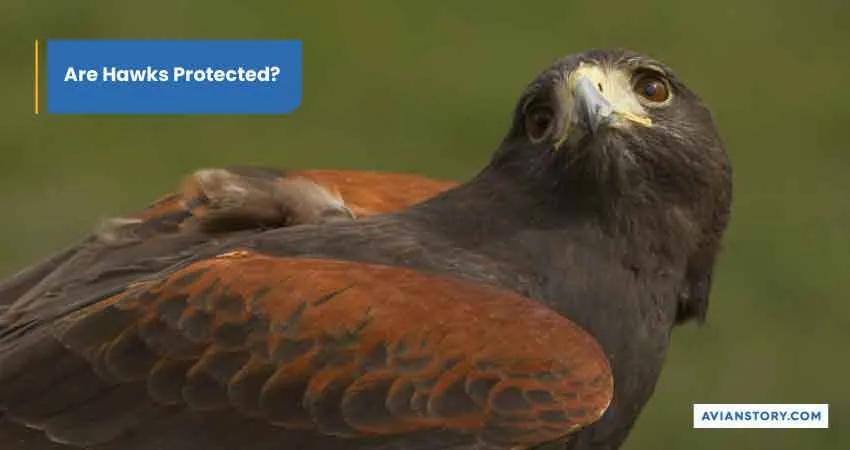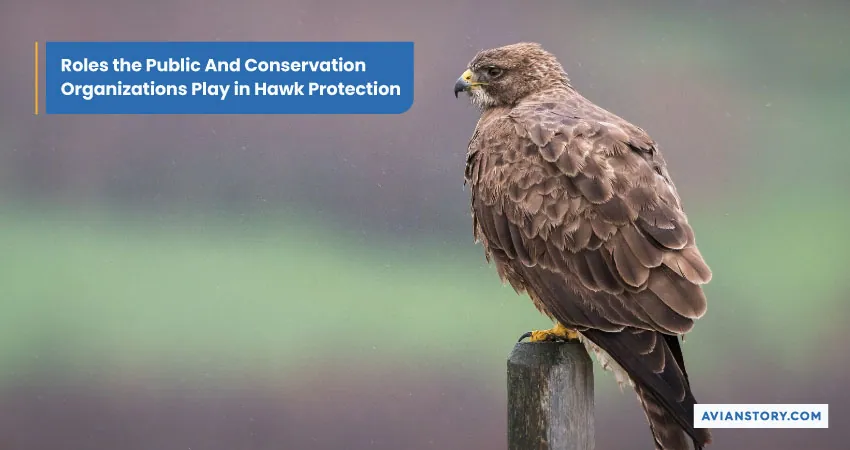Are Hawks Protected? Unveiling Laws And Public Responsibilities
Hawks are magnificent birds of prey known for their keen eyesight and soaring flight. These majestic creatures have captured the imagination of people around the world. However, their populations have faced significant threats over the years, leading to the need for legal protection.
So, are hawks protected? Yes, hawks are protected by the Migratory Bird Treaty Act of 1918, which was further reinforced in 1972 to include hawks specifically. Under this act, it is illegal to kill, trap, hunt, capture, buy, or sell any hawk.
Continue reading to learn the penalties for unlawfully killing a hawk and their exceptions. You’ll also gain a comprehensive understanding of the efforts to protect these remarkable birds and how you can contribute to their conservation.
Are Hawks Protected? Is It Illegal to Kill a Hawk?

Yes, hawks are protected by law in the United States. One crucial legislation that safeguards hawks is the Migratory Bird Treaty Act (MBTA) of 1918. Hawks were added to the list of protected birds in 1972, recognizing the importance of their conservation.
The main provisions of these hawk protection laws include:
- No killing, trapping, hunting, capturing, buying, or selling of any hawk: These activities are strictly prohibited to preserve hawk populations and prevent exploitation.
- Protection of their nest, occupied or not, for at least 10 years of non-occupancy: It is essential to respect hawk nests and refrain from disturbing them, even when unoccupied. This ensures the birds have a safe space for future breeding.
- Cannot remove hawk’s nest and young without the right permits: Disturbing hawk nests or removing their young without proper authorization is against the law. Permits must be obtained for any necessary activities related to hawks’ nests.
- During the breeding season, no activities are allowed within 1.6 kilometers of hawk nests. Breeding season is a critical time for hawks, and it is essential to minimize disturbances.
Penalties for Unlawfully Killing a Hawk
Unlawfully killing a hawk is a serious offense, and penalties are in place to discourage such actions. Below is a table summarizing the penalties for unlawfully killing a hawk:
| Offense Class | Fine Range (USD) | Maximum Imprisonment |
| Class C | 25 – 500 | 30 days |
| Class A | Up to 15,000 | 1 year |
The specific penalties may vary across states, but generally, there are two categories of offenses related to killing hawks.
- Class C Offense: In cases where killing a hawk is classified as a Class C offense, the penalties typically include a fine ranging from 25 to 500 USD and a maximum imprisonment of 30 days.
- Class A Offense: When killing a hawk is considered a Class A offense, the penalties are more severe. Offenders may face a fine of up to 15,000 USD and a maximum imprisonment of one year.
Are There Any Exceptions To Hawk Protection Laws?

While hawk protection laws are designed to preserve these birds, there are exceptions in certain situations. One exception arises when hawks consistently attack domestic birds or cause property damage.
In such cases, individuals may seek a Federal Migratory Bird Depredation Permit, which allows for the lethal removal of problem hawks. You will have to take this permit to the offices of the Service Regional Migratory Bird Permit. And to obtain this permit, the following steps must be followed:
Step 1: Fit the following criteria
- You must be the one experiencing the damage caused by the hawk.
- You are responsible for compliance with the permit conditions.
- You can implement and use non-lethal methods in the future to deter hawks.
- A non-refundable fee of 100 USD must be paid upon application.
Step 2: Follow these rules when using the permit
- No use of any type of concealment during the lethal removal process.
- The killing of hawks must occur within the permitted area specified in the permit.
- Using decoys or calls to lure the bird to the permitted area is prohibited.
- The weapon of choice for lethal removal must be a shotgun not larger than 10-gauge.
These regulations ensure that lethal removal is carried out responsibly and as a last resort when non-lethal methods have been ineffective.
Non-Lethal Methods of Handling Hawks

When faced with hawk-related issues, exploring non-lethal methods to address the problem is important. Here are some strategies to consider:
- Have a watchdog: A well-trained watchdog can alert you to the presence of hawks and deter them from approaching your domestic birds or property.
- Build a scarecrow: Scarecrows have long been used to frighten away birds, including hawks. Create a scarecrow and position it strategically to discourage hawks from venturing too close.
- Remove hawk-perching sites: Identify areas where hawks frequently perch and take measures to make them less appealing. Trimming tall trees or installing deterrents like spikes or netting can discourage hawks from using these perching sites.
- Fencing your coop: Install sturdy fencing around your coop or poultry area to prevent hawks from accessing your domestic birds. Ensure the fencing is tall enough and has a top cover to provide effective protection.
- Provide escape cover for your domestic birds: Create areas of dense vegetation or natural cover where your domestic birds can seek refuge when hawks are nearby. This allows them to hide from potential threats.
- Secure the feeding area: Hawks are attracted to areas where food is readily available. To reduce hawk visits, secure your domestic birds’ feeding areas with netting or enclosures.
Implementing these non-lethal methods can help mitigate conflicts between hawks and human activities while ensuring the safety of domestic birds.
Roles the Public And Conservation Organizations Play in Hawk Protection

Protecting hawks goes beyond legal measures; it requires the collective efforts of the public and conservation organizations. Here are some roles they play in hawk protection:
- Restoration of the hawk’s natural habitat: The public can contribute by supporting and participating in habitat restoration projects. Restoring natural habitats provides hawks with suitable nesting, hunting, and overall survival environments.
- Protecting hawks outside their natural habitat: Hawks often venture into urban areas for prey. The public can assist by reporting injured or distressed hawks to local wildlife authorities or rehabilitation centers.
- Donating to the funding for conservation campaigns: Conservation organizations rely on public support to fund research, conservation initiatives, and public awareness campaigns. Donating to these organizations can contribute to the preservation of hawk populations.
- Using smaller quantities of pesticides in gardens and farms: Pesticides can harm hawk populations by contaminating their prey. By reducing the use of pesticides or adopting alternative pest control methods, the public can minimize the indirect harm caused to hawks.
- Creating hospitals for treating injured, sick, and orphaned hawks: Wildlife rehabilitation centers and hospitals play a crucial role in rescuing, rehabilitating, and releasing injured or distressed hawks. Public support through volunteer work or donations can help these facilities continue their vital work.
FAQs
Here are a few more related questions you might be interested in now.
Are all hawk species protected by law?
Yes, all hawk species are protected under the Migratory Bird Treaty Act of 1918. This act has enlisted most, if not all, of the wild birds in the United States.
How are hawk protection laws enforced?
Hawk protection laws are enforced through various means under the state, including wildlife enforcement agencies, park rangers, and local law enforcement. These authorities monitor and investigate cases of hawk-related offenses and take appropriate legal action against violators.
Are there any federal programs or initiatives dedicated to hawk conservation?
There are federal programs and initiatives aimed at hawk conservation. For example, the U.S. Fish and Wildlife Service works towards conserving birds of prey, including hawks, through habitat management, research, and public education campaigns.
Conclusion
So, are hawks protected? Hawks are protected birds under the Migratory Bird Treaty Act of 1918. The legal frameworks surrounding hawk protection prohibit killing, trapping, hunting, capturing, buying, or selling of any hawk. Special attention is given to protecting their nests during breeding seasons.
Unlawfully killing a hawk can result in fines and imprisonment. However, hawk protection law exceptions exist where hawks consistently attack domestic birds or cause property damage. Understanding the laws and public responsibilities ensures the conservation and preservation of these remarkable birds for future generations.
